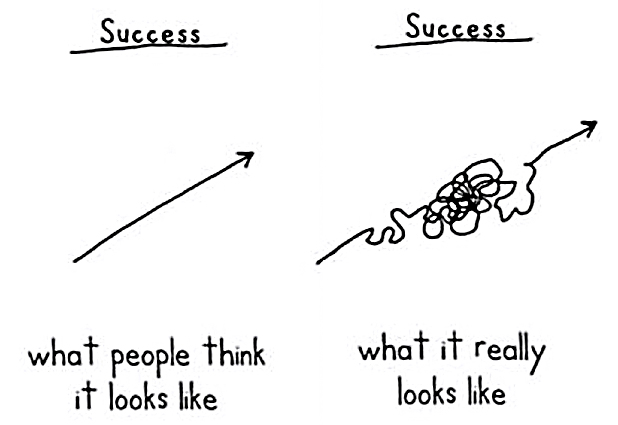Imagine with me for a second that a good friend of yours — let’s call them Pat — says, “Oh, I’ve got to get going. I’m headed to my weekly spa appointment."
What are your initial reactions?
Be honest. It’s just you and a computer screen.
Envy? Anger? Criticism around his or her use of time and money?
Some of you might respond internally with a “Great! Good for you, Pat!”, and not dwell a moment longer.
But I think the majority of us would feel twinges of those aforementioned emotions.
Now you’re just confused and frustrated for feeling that way.
Wait for it….and now the guilt is setting in. A double whammy!
Why can’t we be happily unattached regarding our theoretical friend Pat?
I doubt we’d have the same reaction if Pat had said, “I’m going to the grocery store” or “I’m going for a run."
What’s our problem?
I’d say we’ve got 2 problems. And neither of them are Pat. Pat’s awesome.
1) Our culture
Our culture in the US has programmed us to view people who go to the spa or take time for themselves as self-indulgent layabouts who must not be doing anything meaningful with their lives if they have time for that crap.
A large part of our modern social conduct is based on the rugged individualist.
This term was coined in 1928 by Herbert Hoover and is defined, in part, as “the belief that all individuals, or nearly all individuals can succeed on their own.”
Hoover used this politically to defend his policies of less government intervention and it’s still commonly used by the Republican party today.
But the mindset of the expression has deeply ingrained itself into our already lone-wolf style culture.
The cowboy is the ultimate symbol of rugged individualism. Doesn't get much more American than that, does it?
Image courtesy of 123RF
Rugged individualism translated into the pull-yourself-up-by-your-bootstraps-and-make-your-life-work mentality.
If it’s not working, you’re not working hard enough. Keep your head down and work harder.
Born and bred in the midwest, I can attest to this mentality. It’s rampant.
Anything except for work is floofy crap that you don’t have time for.
A mentor of mine said one of his father’s favorite phrases was “you work hard and you die."
Is it just me, or does this mindset seem really limiting?
Even if we’re not taught these attitudes directly by our families, they are ubiquitous in our culture.
Do things yourself. Don’t ask for help. You need to be self reliant in order to survive.
I don’t know about you, but I’m feeling a little claustrophobic.
2) Our lack of self-care
Thanks to our rugged individualist social programming, we are prone to view any type of self-care as self-indulgence.
And that’s just ridiculous.
We’re not cars that can be driven until something breaks down and we take into the shop to get replaced or repaired. This might seem like a silly analogy, but many people think like this.
They treat their body like a machine. If the engine starts, we’re good to go! No further thought required.
Our bodies and minds require care and ongoing maintenance.
The old saying “an ounce of prevention is worth a pound of cure” is so true.
But we’re programmed to think “work now, worry about health later."
We look at self-care so begrudgingly, it amazes me. Even within myself.
The shower article I wrote — my suggestion adds at most 30 seconds to your morning routine — took me an embarrassingly long time to integrate regularly. Like, until I wrote the article, even though I’d known about it for, oh, 5-7 years.
Our friend Pat is openly defying our culture and saying, "Hey, self-care is ok."
And what do we do?
Get angry. Or jealous.
What’s our deal?
Let’s break down this emotional response.
Jealousy:
Feelings of jealousy and envy come from wanting what we don’t have.
I’d wager to say that the stronger the feelings of envy that came up for you, the more you want what Pat has.
Anger:
Anger pops up because we know we’re not giving ourselves this thing that we want. We’re frustrated that Pat has it and we don’t.
We could have it, we just haven’t admitted to ourselves that we want it, or that it’s ok to have.
Guilt:
We know we shouldn’t blame Pat for his or her choices, so we feel a pang of regret around our emotional response of anger and jealousy.
We might also simultaneously feel guilty for wanting what Pat has, which is a strong sense of self and a willingness to identify his or her needs and act on them.
And now we’re confused.
This jumble of emotions is disorienting — what’s happening? Why? What’s the source?
In the midst of this confusion, we internalize the jealousy, anger, and guilt. We shove them down deep and neglect to process them.
It’s a shame. This triad of emotions is a powerful motivator for change and growth.
They are a signal to us that something’s wrong and needs to shift. It’s not Pat’s fault. It’s far more difficult to admit.
It’s your own fault.
Gasp! But it’s true.
These emotions welled up internally. Pat may have triggered them, but they are yours to own.
It’s uncomfortable to look at ourselves this way, but necessary in order to gain insight into our emotional processes.
The fact is, taking care of yourself isn’t something to feel guilty about, nor be upset with others who take time for themselves.
Self-care isn’t a dirty word.
And we need to start reprogramming ourselves to understand why.
Not taking care of yourself is holding you back
You will never achieve your highest potential if you aren’t connecting with yourself through downtime and self-care.
Not convinced? Take a look at some of the ways overwork (aka not giving yourself a break or taking care of yourself) can effect you:
- Overwork can lead to increased blood pressure, more workplace accidents, stress, and family conflict.
- It’s bad for your brain, this long term study of British office workers found. Those who worked 55 hours/week versus 40 hours/week had significantly more trouble performing cognitive tasks.
- We all know that overworking leads to less hours in the day to complete other tasks, as well as less time to sleep. Chronic lack of sleep can lead to obesity, heart disease, diabetes, and stroke. Even a few nights without enough shut-eye can have effects on memory creation and consolidation.
- When we’re overworked, we have a much harder time making good food choices, that overtime will lead to weight gain and overly just feeling yucky.
- It’s bad for your heart. A large study found that working 3-4 hours of overtime (more than a 7 hour workday) was associated with a 60% higher rate of cardiovascular disease compared with no overtime work.
- Long hours predispose you to heavy drinking, according to this Finnish study that analyzed over 330,000 people and results from 61 other studies in 14 countries.
- Without taking a break and resting, you’re less effective at your job or working toward your goal, this Illinois study found in 2010. Without stopping, we can lose the forest for the trees and are more easily distractible.
- The amount of overtime you put in does not make you more productive in proportion. There are diminishing returns of productivity, around 25-30% for 50% extra put in.
It's a long list that just keeps getting longer as more research is done.
But deep down, we already know the negative impacts of not taking care of ourselves. Or maybe, not so deep down! Sometimes they're very obvious.
You can't keep driving to your goal without breaks. Those are your fuel to keep going.
It’s important to remember that progress is never linear.
Whatever goal or life moment you’re driving after, it’s not going to be a steady, dead straight course. It never is.
There are ups and downs, peaks and valleys, stops and starts. And this is totally normal.
The little moments, or days, or weeks of rest allow something critical to happen: reflection.
Have you ever driven so hard at something you’re blind to anything else, then when you finally achieve it, you don’t really want it?
If we don’t take stock of our process and reassess, we’ll never know if our priorities or desires shift. And they often do.
The journey itself informs our next steps, not the end point.
Self-care is a crucial ingredient to keep us on track toward our goals.
It's never a waste of time, and needs to be made a priority in order for success to follow.
How do we change our limited mentality?
Ok, now you’ve read some of the harmful effects of too much work and too little downtime. Too little self-care.
I know some of you are thinking, “That’s all well and good, but what can I do about it? Because of X, Y, or Z, I can’t change things."
Maybe that’s true for some of you. Maybe you’ve recently been pulled into a crisis situation and you can’t help but be overwhelmed and overburdened at the moment.
But crises are temporary. Eventually, things stabilize.
I would wager that the majority of you are not in crisis, but are instead in a long, drawn out battle with a career or overwhelming responsibilities at home.
There’s only one way for things to get better.
And it’s not to hope that things shift and become less stressful.
These things are out of your control and you can’t allow yourself to be at their mercy. More than likely, you are contributing to this situation without even knowing it.
By not enforcing your own boundaries, you’re taking away your agency. Your sense of self.
In psychological terms, it’s called an external locus of control. You believe that the solution to improving things lies outside of you.
We know this is a fallacy, but most of us fall into this trap on a daily basis.
The challenge is turning this perception around and developing an internal locus of control. Believing that you are central to changing what surrounds you.
Sometimes it's tough to take a look at your life and realize that you engineered it.
But you can change the course of things! These 6 steps to making yourself a priority in your own life will help get you there.
Step 1: Admitting that wherever you are now you created and allowed
We get in our own way a lot.
In fact, we get in our own way far more often than other people do.
We need to take responsibility for our lives. And our current situation.
From what I see, there are two major mental hurdles for people:
#1 We have to admit that we set ourselves up to fail with unrealistic limitations
It’s very easy to pass blame about your situation in life to family, friends, work, or any other responsibility that you feel takes up your time.
“Well, I have to jump rope for 17 minutes at 12:32pm every day because otherwise my pet iguana Larry will get diabetes."
I hope that made you chuckle a bit.
But in all honesty, many of the “rules” we make for ourselves are just as ridiculous. Like “I can’t eat any carbs or I’ll gain weight” or “I have to be finished with 1 hour of exercise by 6:30AM or my day is ruined."
These might hit a little closer to home. Of course, they are a little more grounded in reality as well.
But I hope the point I’m trying to make is not lost.
We set up silly rules to place limits on ourselves that in turn give us excuses to fall into our intended or pre-thought out outcome.
Simply put, we set ourselves up to fail.
We don’t believe we can achieve something, so we start with an unrealistic limitation.
We tell ourselves “I told you so!” when we soon fall off the wagon, and we go back to being stuck in our miserable, stagnant, unhappy place in life.
This is called a self-fulfilling prophecy, and it’s used time and time again by people who have the best intentions of changing, but who don’t believe they can make the change they’re after.
A failure is all they need to stop trying and confirm that nope, they really couldn’t handle it. They let themselves off the hook and go back to their zestless, but comfortable world.
Any change is uncomfortable, and many people would rather stick with the devil they know than venture out and explore new options.
So much so that they constantly set themselves up as the fall guy in their own lives.
#2 We have to admit that we have a choice in everything we do
It doesn’t feel that way, does it?
“I mean, come on Dr. Liz, I have to feed myself. And Larry needs his scales polished and shined. He doesn’t look as snazzy otherwise."
There is nothing that you *have* to do.
Do you read me? 10/4, good buddy?
Everything is a choice. We just don’t like the consequences of some of those choices, so we don’t consider them an option.
Let’s take the two examples from above.
| Choice | Consequence of Action | Consequence of Non-action |
| Eating | satiation, satisfaction, better performance | hunger, irritability, fatigue |
| Polishing and shining Larry’s scales | snazzy scales, Larry mildly approves of the attention | less snazzy scales, Larry possibly becomes mildly disgruntled due to lack of snazz |
You can see there are consequences to both taking action and not.
Consequences aren’t always bad! They’re defined as any outcome to a situation.
You can certainly choose not to eat, but we prefer satiation to hunger and irritability.
And Larry may like his scales polished (we’re not actually sure; iguanas are a stoic bunch), but it is an option not to do it for him.
Let’s take a look at the second consequence for not polishing Larry’s scales.
I said that Larry would *possibly* become disgruntled. We don’t know, because we’ve never missed a day.
It’s important to explore hypothetical outcomes as well because these are usually the most important.
We fear what we don’t know and fear is arguably our most deeply rooted emotional response, going back to fight-or-flight, survive-or-die.
Ok, so we’re not going to die if we don’t polish Larry’s scales, but the fear behind what else could happen that’s not been discovered yet is very real.
Oftentimes fear is enough to keep us locked in bad habits and choices.
Then we resent whatever that choice is and the person (or animal) attached to it.
Again, we’ve locked ourselves into a cupboard and thrown away the key.
Out of our own volition. And our own fear.
Once we realize there are choices to everything, we can start making more informed decisions.
We can stop avoiding thinking about certain outcomes because we simply don’t want to see them.
We can finally get a grasp on what’s really necessary in our lives and the mess we’ve gotten ourselves into by sticking our heads in the sand.
Take a deep breath. It’ll be ok. Even Larry thinks so.
Step 2: Taking responsibility to acting in your best interest
So you’ve admitted that you’ve created the issues in your life.
Awesome. Taking responsibility feels weighty, but good.
Now you can really start changing!
#1 Set realistic expectations/limitations
Let’s stop setting ourselves up to fail, shall we?
How about we set things up so we can *actually* succeed? Crazy, right?
Here’s how you start.
You have to believe the you can succeed.
You’re not going to get anything off the ground if you don’t think you’ll make it.
It’s time to suspend your inner critic and bring in your cheerleader.
Think positively. Believe things can happen the way you want.
Affirmations can be a helpful tool at this stage.
Affirmations are positive statements in present tense that you repeat to yourself throughout the day, ideally out loud and in front of a mirror.
You might not totally believe them when you say them, but this is a fake-it-til-you-make-it situation.
You know how if you smile enough, it lifts your mood?
This is the same concept. Affirmations aren’t going to solve your problems for you. But they are going to help reduce your anxiety and fear and boost your self-confidence and motivation.
Try something like:
“All is well in my world. I am happy, content, and I do meaningful work."
“This situation is present in my life for my greater good. I am strong, centered, and confident."
“My life is perfect, whole, and complete."
If you don’t like these, write your own! Just remember they need to be in present tense! Currently happening to you! Not future tense.
From this more calm, stable place, you’ll be surprised at how much you can clarify in your life.
When you believe in yourself, you begin seeing what’s realistic and what’s not.
You want to achieve. You want to break out of that comfort zone.
Because why not?
The only thing stopping you is yourself.
These skills take time to develop, but the more you use them, the easier this positive outlook and setting realistic limits for yourself becomes.
Let’s look at how to reframe the “I can’t eat any carbs otherwise I”ll gain weight” statement.
It should be pretty obvious how this is unrealistic. Especially if you have a sweet tooth.
That doesn’t mean we shouldn’t pursue a version of this goal. Like “I’m going to cut out refined sugars and refined carbs.” Already more realistic.
Now what do we need in order to make this happen?
Small steps.
Jumping in cold turkey will be overwhelming and make us prone to self doubt and failure because we haven’t set up our resource net yet.
So, what are our resources? In other words, what do we need to succeed?
Work backwards from your larger goal. Draw a mind map or a timeline or linear progression.
With each step backward, ask yourself “What can I do today?” This will help you break your goals down into smaller pieces that you can actually work on.
Can you stop eating those carbs today? Well, no, you’ve got a potluck or dinner planned already.
Can you start cleaning out your pantry and fridge? No, you need food for the rest of the week until you can make it to the store.
Can you research blogs and articles on people’s experiences cutting out refined sugars and grains? Yes, you’ve got a few minutes.
See how it works?
#2 Map out consequences
Make a list of the areas of your life where you feel like you don’t have a choice.
Then write out the good and bad consequences of taking that action and of not taking that action. Even the hypotheticals.
You’ll now have a mini pros and cons list for each choice, and you can see clearly what each choice is costing you or gaining you.
The purpose here is to dig in and see what you have unconsciously brought into your life.
You need to create awareness around these decisions so you can determine if they still have a place.
Many will not once you see what they’re costing you. Which is fabulous.
We all need to prune our lives and remove things that aren’t helping us to grow.
Doing this exercise should help you crystallize what needs to shift in your life.
Then you’ll be acting in your own best interest. It’s strange how difficult that can be sometimes.
Step 3: Create and learn to enforce boundaries
Now that you’re rooting for yourself to succeed (yay!) and have an idea what you might want to filter out of your life as well as bring in, how do you make this happen?
You create boundaries.
Boundaries also seem like a dirty word in our culture.
We should be open to everything all the time, otherwise we’ll miss out. This has become known in pop culture as fear of missing out, or FOMO for short.
What, I ask, are we so afraid of?
That one magical opportunity that will change our lives forever? Fairytale land, my sweet sugar pies.
You create your own opportunities.
When you know yourself, this comes naturally. You know want you want and what will serve your highest purpose and interests, and you go after that.
And you don’t look back. There’s no FOMO because you know yourself well enough to understand those other options weren’t for you.
Self-definition, or having boundaries, is a good thing. You can’t be everything to everybody.
Nor would you want to be. Then who are you? A selfless person catering to many but never developing their own life.
You’re essentially hiding behind others so you don’t have to do the hard work in your life to figure out who you are and what you want.
Harsh perhaps, but true.
Of course we have to make sacrifices in life and can’t single-mindedly pursue our dreams every minute of the day.
Parenting requires mountains of self-sacrifice, but that doesn’t mean we have to lose ourselves.
Modern day jobs also seem to require a high level of sacrifice. Work bleeds into weeknights and weekends and it’s assumed by many that that’s just how it is.
Well it doesn’t have to be.
Be the kid who colors outside the lines on purpose or makes the ocean pink instead of blue. Be different.
Just because lots of people are doing it doesn’t mean it’s the right thing to do. Seems obvious, doesn’t it?
It’s the lemming joke from your childhood — “if your friends jumped off a cliff, would you?”
We’d like to think we'd answer no, but so many times it’s yes. Social pressure and societal norms are powerful drivers.
But they don’t have to be your drivers. You can get out anytime you want.
You need to create safe places in your life where other responsibilities don’t bleed in.
Boundaries send an important message.
They only start to take shape when we know who we are and what we want. Or at least the ones that stick.
We can set up arbitrary boundaries all day, but they would do little good because you wouldn’t enforce them as they don’t mean anything to you.
Start by thinking about which areas of your life need to be protected.
Which areas do you feel like are hurting the most right now?
Then ask yourself what’s hurting them. What’s taking time away from them? Make a list.
An example might look like:
| Needs to be protected | What does it need to be protected from? |
| Time with Larry | • Watching too much TV
• Work overflowing into quality iguana time • Larry’s rampant fan club responsibilities |
Larry needs quality time with you. It’s valuable to both you and Larry and you want to always make it a priority in your life.
Now the first two areas that are threatening time with Larry are under your control. You can decide to watch less TV and interact more with your lovely iguana.
Your day job overflowing into weeknights and weekends is a little more complicated fix.
That will most likely take several small steps in order to really shift things. And that’s ok.
Just start with what we talked about earlier — ask yourself “What can I do today?”
Work backwards until you find something. Then you’ll have a roadmap for how to get there incrementally.
Larry’s fan club is another issue. He has quite an Instagram following. You can’t control those people and when they comment on something and expect you to respond.
So brainstorm times that work for you to respond and limit how long you spend on them.
For example, 15 minutes in the morning and 15 minutes in the evening. People will always want more Larry. But that doesn’t mean they have to run your life.
Boundaries are an assertion of the self.
They say “Hey, I’m a valuable person and I believe in myself."
Again, this skill is like a muscle.
If you keep going to the gym everyday, you’re going to start to see some muscle definition and eventually those weights get easier and easier.
Step 4: Make time for yourself consistently
Now that you’ve got some baby boundaries started or old ones reinforced, you can start making time for yourself and your priorities consistently.
You’ve cleared space in your life for things to grow.
What’s important in this stage is that it’s ok if you’re not sure what you’re making time for.
Maybe you don’t have a Larry in your life, but you know you need to set boundaries because work, family, etc., is overwhelming you and stressing you out.
You know in your guts that you need time to yourself.
At first that might just be sitting on the couch and watching your favorite movies. A very passive activity, but that’s ok.
The point is you’ve created more time for yourself.
We’re often so overstimulated and backlogged with emotional processing that when we first create space in our lives, all we can do is be passive. Let things slowly process out.
There are many more ways to help process, but if you’re just beginning, you might not have any of those tools in your belt yet.
Sometimes it’s hard enough to enforce new boundaries and feel good about it. Sometimes you just need to marvel at the space you’ve created and wonder what else you could change.
Or wonder what the next episode of Bob’s Burgers will be like and guess the pun he makes in his burger of the day.
Right now you’re tending the soil of yourself. Not even planting seeds yet. Enriching it with nutrients, weeding it. Setting up those new seeds you’ll plant for success.
This is a wonderful place to be. But it’s one of the hardest because we feel like we have nothing to show for our new sense of self. We’ve created space in our lives, but have no tangible product yet from our efforts.
Patience, young Padawan.
US culture really doesn’t like downtime. If we have any, we're compelled to fill it immediately.
Ah, the glorification of busy.
You’re really bucking a societal trend if you’re not going 24/7.
But if we’re moving that fast, we never have time to process our lives and think critically about them.
More likely than not, we’d find things we don’t like and would want to change them. And change is hard.
Be proud that you’ve created space for yourself to grow into.
You’ll be surprised at what begins to surface when you make this space a priority.
Try to make it a daily occurrence.
Set an amount of time and a time of day each day to do whatever you want.
For example, 15 minutes at 9:30pm when everyone else has gone to bed.
Even 5 minutes is a start. Snatch moments when you can through the day and give yourself a bigger chunk at the beginning or the end.
Some days you’ll be too tired or busy or distracted. But shoot for a few days a week and let it grow from there.
On days you don’t make the space, you’ll miss it.
Which is great because you’ll be motivated to stay committed.
It feels great to give back to yourself. Soon a habit will form.
And you’ll be asking yourself, “How did I live without this?"
Step 5: Discover what you really like to do
This step may happen simultaneously with step 4.
When you create time for yourself, you’ll naturally start asking, “What do I love? What do I need more of in my life? What brings me joy and satisfaction?”
We ask ourselves this far too infrequently.
If you haven’t pondered these questions yet, sit down and do it. Brainstorm, and have fun! Make a list! Make lots of lists!
Think about everything you’ve wanted to do but haven’t yet. Things might include, but are not limited to:
- Gardening
- Writing
- Painting
- Learning the cello
- Filming a claymation version of Transformers
- Knitting sweaters for penguins (this is a thing)
The sky is the limit! When you’ve successfully staked out boundaries and have downtime to work with, your creative juices will start flowing.
The key word in all of this is CREATIVE!
Creating is an excessively underused and undervalued part of us.
We’re taught to consume and consume by our culture, robbing us of the joy and utter satisfaction that comes from producing something and putting it out into the world (privately or publicly).
It doesn’t matter if it’s a masterpiece or not, creating is therapeutic.
In fact, it’s better if it’s not a masterpiece so you don’t consider your creative time as an outlet only worth of creating the best, whatever that means.
Image courtesy of Huffington Post
Your creative time is for you only, no one else.
No expectations, no limits.
If a personal masterpiece pops out, awesome. If not, it doesn’t matter. You’re engaging in the process, which is the most important part.
Creating feeds your soul.
It nourishes you. You expend energy, but often feel invigorated afterward.
It’s also essential for processing our emotions.
Creating transforms all that muck of uncomfortable emotions like guilt, anger, and grief into something beautiful.
Think of those (or any) emotion as your raw material for your product, whatever you’ll create.
Just like in any creative process, you use up raw materials to complete your vision.
The same is true with emotions. If you create something with them, you’ve processed them. You’ve turned them into something completely different.
They’re no longer floating around and wreaking havoc.
If they are still there, ok, there’s more to process!
So more time needs to be set aside with those new boundaries so you can work through them.
It’s also a highly underrated coping mechanism.
And many people haven’t taken the time to tap into it.
Once you find a few things you want to spend your time on, you’ve planted the seeds. Then you just need a couple ingredients (or supplies) and time to watch them sprout and grow.
The more consistently you find time, the more this skill will develop.
The more it develops, the happier and more well-adjusted you’ll be.
And you’ll defend that time you’ve taken for yourself from other things that want to creep in.
You’ll naturally start reinforcing the boundary you created because you’ve found something much more valuable to you than the other crap that seeps in and sucks away our time.
You’ve made yourself a priority in your own life. Just like Pat. How fabulous!
I hope you can see now that self-care isn’t selfish at all. It’s about self-preservation and experiencing the kind of life that you want.
Step 6: Always be willing to adapt and change
In order to keep your awesome creative habits going, you have to go with the flow.
Life will change. You will change. We’re always evolving and our ideas of satisfaction and happiness evolve with them.
The only constant in life is change, says the old adage.
Things will be overwhelming at times and calm at others. The trick is staying devoted to yourself throughout the ups and downs.
You might not be able to devote as much time or have a consistent schedule through busy periods, but keep some semblance of your boundaries for yourself going.
Don’t let everything you’ve built collapse, if you can help it.
Let’s say it’s a worst case scenario and you do let things go.
You’ve completely stopped knitting tiny, adorable sweaters for penguins. You don’t know when you’ll be able to pick it back up again.
Here’s the great news. It’ll be like riding a bike.
Once you’ve carved this path for yourself, it will always be there.
You’ve dedicated a significant amount of time and effort to creating this path (see steps 1-5).
I tell my patients it’s like shoveling a path through snow. It’s really arduous. You need a break, or something calls you inside, so you leave the path and shovel.
When you come back, your progress hasn’t disappeared. That 10 feet of path you cleared is waiting for you. You can walk down it easily and get right back to where you were, pick up your shovel, and start moving forward again.
It’s nothing to be ashamed of if you fall off the wagon. It will happen.
These are new, wobbly, gangly baby deer habits you’re forming. You stumble, fall, and get back up again.
The more time and space you allow your self-care routine to grow, the more stable those legs will be and the more mature the skill set.
Self-care will become an anchor for you. It reminds you of who you are and what you love.
The more we can stay connected with that, the better.
There will always be things pulling you off balance, and over time you'll develop the flexibility and foresight to plan for them and adapt.
Because you value taking care of yourself
Self-care is essential to our wellbeing
I hope you’ve seen the amazing life-transforming power of self-care.
You don’t have to be jealous, angry, or feel guilty when your friend Pat goes to the spa.
You think, “Great! You’ve got your thing, I’ve got my thing."
Those negative emotions melt away because you know you’re taking good care of yourself. You’re making yourself a priority.
If they pop up, remember they are harbingers of old habits slipping back in. Don’t blame Pat!
Realize that you haven’t devoted enough time to yourself lately.
Remember that taking time for yourself is not self-righteous or a luxury only afforded to some.
Anyone can make themselves a priority in their own life.
And it’s unequivocally necessary in order to have a satisfying and fulfilling existence on this earth.
It’s a short one. Make it great for yourself.













